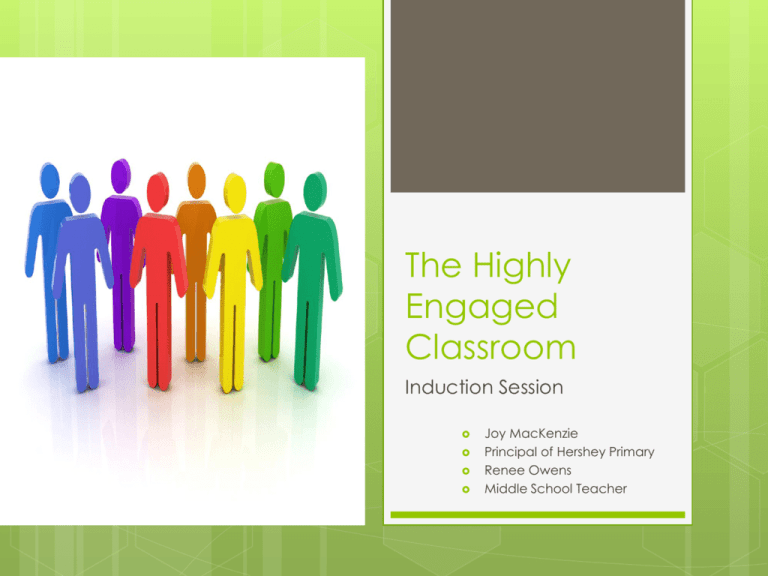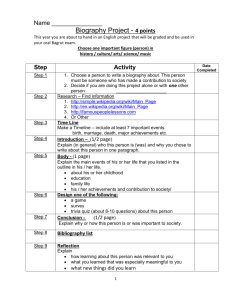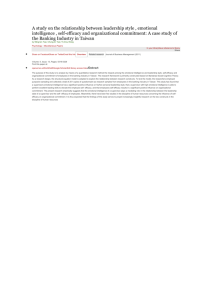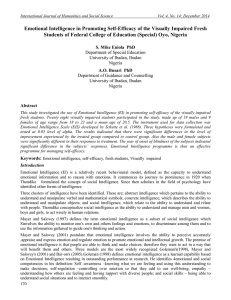The Highly Engaged Classroom - Will2Will
advertisement

The Highly Engaged Classroom Induction Session Joy MacKenzie Principal of Hershey Primary Renee Owens Middle School Teacher Bell ringer: What is engagement? Please take a few minutes and write down some descriptors of what it “looks like” and “sounds like” when students are engaged in your classroom. We will compare this definition with one you will describe at the end of this session Essential Questions: What can I do to get students’ attention? What can I do to keep students engaged? What will work for me? What will I take back to my classroom to implement? Introductions Questions on the move Activity Find out more about the group Debrief How/Why is this engaging? Materials for today’s class: https://will2will.wikispaces.com/Professional+De velopment Working Definition of Engagement Attention: How do I feel? (affective side of learning) Am I interested? (extent to which classroom activities intrigue students) Attention is a short-term phenomenon that ranges from a few seconds to a few minutes Working Definition of Engagement Engagement: Is this important? (extent to which students perceive classroom goals as related to their personal goals) Can I do this? (extent to which students have or cultivate a sense of self-efficacy) Engagement is a more long term phenomenon lasting beyond initial attention A Bit of Research: Students will fill their “working memory” with “permanent memory” if they are not engaged. Outside World Sensory Memory Working Memory Permanent Memory Part One: How do I feel? How do I Feel? Students will be more engaged in a lively, positive and accepting classroom Effective Pacing Transitions Presentation of new content Commitment and Community Let’s look at the Teaching Rubric The classroom environment Creating an environment of respect and rapport Establish a culture for learning Managing classroom procedures Managing student behavior Communicating clearly and accurately Engaging students in learning Effective Pacing Pacing too slow– energy drops; too fast and students can become confused Need routines for Handing in assignments Distributing materials Storing materials after activity Getting organized into groups Whip around/pass around Choose one of the previous areas and tell us what that routine looks like in your room Other ideas? Student Grouping Jigsaw “active participation strategies” Be ready to share with the group Transitions Entering the classroom Posting expectation Write to a prompt Check homework Think-pair-share to a question Transitions What to do when I am through? Helping other students Work on more advanced content Studying a topic of their own choice Homework Read Transitions Exiting classroom Ticket out the door Question for the next day Reflection/Summary Lino.it Let’s try it Presentation of New Content Chunk and Chew 3 minute pause Knew and new Ask a question (students of each other) Incorporating Physical Movement Inside/outside circle Four Corners Vote with your feet Give one, Get one Classroom Community Student inventories 3X5 cards Name Three words to describe me Learning is fun when I like classes that Something that really challenges me is Student/Teacher commitments Reflection What were strategies you already knew? What is something new that you can use? Part 2 Am I Interested? Strategies to increase interest Games Interesting facts White boards Anticipation Guides Surveys Questioning to increase response rates Let’s look at the teaching rubric Establishing a culture of learning Demonstrating knowledge of students Selecting Instructional goals Using questioning and discussion techniques Engaging students in learning Games Questions Each student has a card with one question to ask and one answer that belongs to someone else’s question Which and answers connect one doesn’t belong? 4 vocabulary or concepts/3 are related; one is not Interesting Information Unusual information The New York Times (www.nytimes.com) science, social studies and language arts Federal Resources for Educational Excellence (http://free.ed.gov) science, social studies, language arts, math The History Channel (www.history.com) “This day in history” Trivia Library(ww.trivia-library.com) all content areas Book: Napoleon’s Buttons: 17 molecules that changed history Students can find unusual information/put on wiki site etc. Personal stories to illustrate a point or concept Don’t do trivia to do trivia– link to content QR scavenger hunt Movie clips, music etc. Questioning to increase response rates Answering a question occupies a student’s working memory Call on students randomly Paired responses Wait time (varies) Error correction Simultaneous responses All write, choral responses, signals, response cards, act-i-votes Reflection on part two How can these strategies increase student attention? Which would be most useful at this time in your classroom? Part 3 Is this important? Is This Important? Relating objective or essential question to real life or larger context (rationale) Allow choice Choice of task Create a poster illustrating the main themes in “To Kill a Mockingbird” Investigate the time period in which “to Kill a Mockingbird” takes place. Compare and Contrast that time period with current time. Strive for higher level (HEAT FRAMEWORK) Analyze Argue Against Compare/contrast Criticize Defend Evaluate Interview Recommend Is This Important? Choice of reporting format Written Oral Debate Demonstration Visual representation Drama, Song, Rap Reflection on Part 3 How can you take one of your assignments and provide student choice? Be ready to share with the group Part 4 Can I do this? Self-efficacy Most important factor Tracking progress Effective Verbal Feedback Look for opportunities to assess selfefficacy, and integrate the concept into your classroom Respond to these 3 questions Strongly Agree(1-2-3-4-5)Strongly Disagree You have a certain amount of intelligence and there isn’t much you can do about it Your intelligence is something about you that you can’t change very much You can learn new things, but you can’t really can’t change your basic intelligence Two Theories Entity theory (fixed intelligence) Incremental intelligence) How theory (growth in can we make a shift? Jigsaw article by Carol Dweck Break into groups Read a portion of the article Write main points on a poster paper Share Choice of output (example: voice thread or google docs) Self-theory survey Designed by Carol Dweck (2000) Ask three questions using a 5 point Leiter scale Keep the conversation alive How does your self theory affect you in school? What are you doing to enhance your belief in the growth theory Track Progress Visual representation of progress Graphs Rubrics Checklist Goal setting Specific written feedback Providing feedback Avoid fixed characteristics – “see how smart you are” (either you have it or you don’t) Praise effort and quality of work– link two together Specific feedback Examples Successful student performance Point out aspects of the task that were done well Comment on obvious effort and preparation Learned helpless concept Unsuccessful student performance Point out aspects done well and done less well Asks about effort and preparation Integrating Self-efficacy Stories about the power of efficacy Dare to Dream! 25 Extraordinary Lives (Humphrey, 2005) Movie Clips: The Pursuit of Happyness; Babe Quotes/discussion of quotes about efficacy The man on top of the mountain did not fall there– Anonymous Genius is 99% perspiration and 1% inspiration— Thomas A. Edison Reflection Think of a time when you contributed to a student’s self-efficacy or when you as a student had a teacher who did the same Share this example with a partner And in conclusion What is your “take-away?” 3 things to consider 2 “must do’s” 1 major “ah-ha” Resources for presentation The Highly Engaged Classroom. 2011. Marzano. Solution Tree Publishers How to Teach so Students Remember. 2005. Sprenger. ASCD Publishers Summarization in Any Subject. 2005. Wormeli. ASCD Publishers Thanks for Coming





